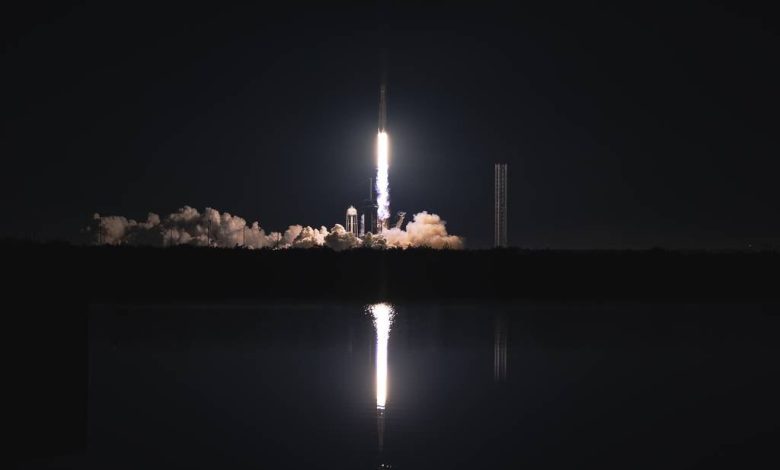US Space Force plans to boost competition for launch business. Will it work?

Whenever the U.S. military launched a satellite over the last six years, the rocket carrying that payload bore the logo of SpaceX or the United Launch Alliance — the only companies eligible to fly National Security Space Launch missions.
Rocket Lab CEO Peter Beck has watched those launches while smaller and emerging providers like his own company lacked a clear pathway to compete for the missions.
He and other launch executives have encouraged the Space Force to create entry points for firms building new rockets. And now they may have a way forward.
The Space Force announced last year that the next phase of its strategy for procuring launches would set aside missions for new providers. It was welcome news for Beck, who believes his company’s Neutron rocket, still in development, will be a top contender.
“That was the right approach,” Beck told C4ISRNET in an interview. “We really wanted that approach to occur, and we were very vocal that that’s the way it should be.”
The strategy for Phase 3 of the Space Force’s National Security Space Launch program, or NSSL, includes two lanes in which companies can compete to launch military satellites.
Lane 1, which will include 30 launches from 2025 through 2034, is for new providers. Missions in this category have less stringent requirements, and companies will have a chance to join annually as they prove their rockets are ready.
The service plans to select initial, eligible Lane 1 companies this spring but won’t award the first round of contracts until next year. While launch vehicles don’t need to move through the traditional certification process, firms must fly their rockets by Dec. 15, 2024, to receive an initial contract.
The remaining 49 launches will carry heavier Space Force payloads and are reserved for companies able to meet a more stringent set of security and performance requirements. Contracts for Lane 2 are expected this summer.
Most of those missions will go to two firms — likely incumbents SpaceX and ULA — but the service has the option to choose a third provider if a company presents a sound plan to certify its rocket for Lane 2 launches by 2026.
If the government selects a third firm, it will likely be Blue Origin, whose New Glenn vehicle — designed to fly large payloads — is slated to fly this year.
Smaller companies have long-term ambitions to compete for more lucrative contracts, like those in Lane 2, but are targeting the more accessible missions in Lane 1 in the near term. As the deadline approaches for the Space Force’s first round of selections, none of those newcomers expect to have their rockets off the ground in time to qualify.
Rocket Lab’s Neutron was closest, according to its internal projections, but the firm announced May 6 it is now targeting mid-2025 for the vehicle’s debut.
Other companies developing medium-lift launch vehicles — which can carry 4,400-44,100 pounds into orbit — to compete for Lane 1 contracts include ABL Space Systems, which is targeting next year for the first launch of its RS1 rocket; Firefly Aerospace and Northrop Grumman, who are working together to develop the Medium Launch Vehicle and also aiming for a 2025 flight; and Relativity Space, which expects to fly its Terran R rocket in 2026.
Those timelines mean that — despite the Space Force creating opportunities for emerging launch vehicles to compete — initial contracts for those missions could end up going to NSSL program incumbents and potentially Blue Origin in Lane 2.
Development delays
Launch executives and outside experts aren’t surprised by the rockets that remain ineligible to receive contracts next year, despite the Space Force’s strategy.
While the initially slow on-ramp to competition may present a symbolic blow to the service’s approach and raise eyebrows in Congress, the reality is that developing launch systems is challenging and schedules tend to slip — as evidenced by Rocket Lab’s latest setback.
“Getting Neutron to the pad this year was an ambitious greenlight schedule that we had — a path to closing if every single aspect went according to plan,” Beck said in the company’s May 6 earnings call. “As we’ve always said, this is a rocket development program and this is always filled with gremlins, some in our control and some not.”
Gen. Chance Saltzman, chief of space operations for the Space Force, cautioned against downplaying the significance of the on-ramp opportunities that the service is providing in its strategy.
“The on ramps and off ramps — we shouldn’t just cast those aside because there are companies at different stages of development,” he told reporters April 10 at the Space Symposium in Colorado. “We’ve tried to account for that in our acquisition strategy so that as they develop, as they mature, there’s pathways into contractual arrangements.”
The bigger question, experts said, is how many of these companies can, in the coming years, make a place for themselves within a multibillion-dollar national security launch market dominated by a single player — SpaceX.
The answer to that question will depend on several variables, including commercial launch demand and the continued pursuit of proliferated satellite constellations from both government and private sector customers, according to Joshua Huminski, senior vice president for national security and intelligence programs at the U.S.-based Center for the Study of the Presidency and Congress. The organization partly focuses on how leaders can address national challenges.
“The demand from the commercial market — which is really going to keep a lot of these companies afloat and in operation — is going to be almost a driver, and it’s a question of: Can the national security space enterprise keep up?” he told C4ISRNET.
Another factor is whether the Space Force can keep its launch procurement strategy agile enough to adapt to that dynamic market. Todd Harrison, a senior fellow at the American Enterprise Institute think tank, said the Space Force should focus on creating an environment that fosters competition rather than try to choose winners and losers through a more restrictive approach.
“I think what we should do is try to create the conditions so that the next SpaceX can emerge,” he told C4ISRNET.
SpaceX dominance
That “next SpaceX,” of course, would be competing with the actual SpaceX, which is owned by billionaire Elon Musk and has a tight hold on the U.S. launch market. The company’s Falcon 9 rocket flew 207 of the 256 domestic launches conducted between 2020 and 2023, according to data compiled by Harrison.
The firm’s dominance in the military market traces back to 2014, following Russia’s annexation of the Ukrainian territory of Crimea. At the time, ULA — a joint venture of defense giants Lockheed Martin and Boeing — was the sole-source provider of military launches for the U.S. government.
The Russian-made RD-180 engine powered ULA’s workhorse rocket, the Atlas V. Concerned that the U.S. was too reliant on the Russian propulsion system, Congress called for the Pentagon to end its use of the engine and ensure the military is not dependent on a single company to carry national security payloads.
The Defense Department responded in two ways. It developed a process for certifying more rockets to fly these missions. And it provided seed funding to three firms so they could mature their designs for domestically produced rockets: ULA’s Vulcan, Blue Origin’s New Glenn and Northrop Grumman’s OmegA.
Ultimately, SpaceX — which received no DOD development funding but did get money from NASA for its Falcon 9 rocket — was the first new company to successfully onboard an American-made launch vehicle through the Space Force’s certification process. In 2018, SpaceX launched its first national security payload. And in 2020, along with ULA, it won a five-year contract to fly military missions.
Meanwhile, ULA began phasing out its Atlas V rocket and shifted its focus to a new U.S.-sourced launch vehicle, the Vulcan Centaur. The rocket, initially slated to fly in 2019, took its maiden flight in January 2024, after repeated development delays. It must fly one more non-DOD mission before it is certified for NSSL launches.
Surging demand
These events ultimately positioned SpaceX as one of the U.S. military’s primary source of launch services and have helped support its rise in the commercial market.
Following Moscow’s full-scale invasion of Ukraine in 2022, Western militaries followed the Pentagon’s earlier course of action and divested Russian-made components from their supply chains. That included Russia’s Soyuz rocket, which at the time held about half of the global launch market share.
Bonnie Triezenberg, a senior engineer at the think tank Rand, described the Soyuz rocket, prior to the 2022 invasion, as “the only counterweight to the Falcon 9.”
“When the Ukraine invasion happened was really when Soyuz was taken off the market,” she told C4ISRNET. “All of that backlog that was on the Soyuz, a couple of them went to India, but the bulk of it all went onto the Falcon 9.”
The exit of Soyuz from the global market came amid a surge in demand for launch services that analysts expect to continue for some time. Quilty Space, a Florida-based consulting firm, estimated in a 2023 report that 20,000 new satellites will be sent to orbit by 2030.
That demand and the state of the Soyuz — combined with recent retirements of many medium and heavy rockets — created a gap in the number of launch vehicles available to meet that demand, Triezenberg said. That gap has drawn companies like Rocket Lab and Firefly, who have a foot in the small launch market, to branch out to medium-lift systems.
Caleb Henry, the director of research at Quilty, said there’s room for more firms to compete in the medium-lift market, but that questions remain about demand, which could shape how much capacity is needed in the long term.
“I do think there’s a role, certainly, for one or more companies to fill that gap,” he told C4ISRNET. “But I don’t have a good guess on how many medium launch vehicles the market will support.”
Triezenberg echoed that sentiment, noting she’s surprised at how many rocket providers started developing medium-lift rockets in recent years. It’s only a matter of time, she said, before the competition starts to thin.
“Things have gotten pretty frothy in the last few years. Everybody’s throwing their hat in the ring,” she added. “You’re going to see some of that froth come out.”
Building a backlog
The lack of affordable launch capacity in the medium and heavy lift markets is what is driving Relativity Space’s development of its Terran R rocket, according to Chief Revenue Officer Josh Brost.
The company has described its approach as customer-centric, focused on containing costs by 3D printing major parts and designing others to be reusable. And while the 270-foot-tall Terran R is “optimized” for launches to low Earth orbit — about 1,200 miles above the planet’s surface — Brost said the vision is for it to fly more stressing missions to higher orbits.
One of the most important parts of Relativity’s strategy, according to Brost, is early spending on manufacturing capacity, which the company hopes will allow it to quickly scale Terran R production.
“Even if you’re reliable and provide great economics, if you can only launch a handful of times a year, you don’t actually move the needle on the market,” Brost said. “The supply-demand imbalance is strong enough now that to be compelling, you need to be coming into the market with lots of capacity.”
Like many of the other emerging rocket companies, Relativity has secured a strong backlog of business for Terran R, despite it never having flown. The company has already signed commercial launch contracts cumulatively worth about $2 billion.
“We have people signing deals today for 2027, 2028, despite the fact that we’re still evolving, because they see the need for the capability we’re developing,” he said. “The commercial market is becoming the first buyer of capability, and then the defense market can benefit from that commercial marketplace.”
The Space Force may not be the biggest customer for Relativity and other growing rocket firms, but its launch needs are still a significant part of its business case. Military launch will likely account for about 30% to 50% of the addressable market for these companies, according to Rand’s Triezenberg.
Although it’s not the Defense Department’s goal to choose which rockets will succeed in the broader market, Triezenberg said the backlog many of these companies have secured indicates that the service’s Phase 3 strategy, and ultimately its procurement decisions, will play a role in how these companies fare.
“I think what the government is trying to do here with the Phase 3 Lane 1 contracts is sort of [build] up the backlog for these emerging providers,” Triezenberg said. “That’s going to help these firms when they go to the capital markets and try to raise money.
“Launch is a very capital-intensive business,” she added. “Those backlogs are important.”
Conditions for competition
While the Space Force’s launch procurement strategy offers the opportunity for new launch providers to compete, some experts and members of Congress have questioned whether there’s more the Pentagon can do to lower barriers for these companies.
Rep. Dale Strong, R-Ala., said May 1 during a House Armed Services Committee hearing that while he applauds the Space Force’s Phase 3 approach, he’s worried established players like SpaceX and ULA will encroach on Lane 1, underbidding on those missions in order to edge out smaller firms.
“I do have concerns about Lane 1,” he said. “I would personally like to see something a bit more concrete to protect them.”
Beck, Rocket Lab’s CEO, told C4ISRNET he’d like to see rules addressing which missions Lane 2 companies can and cannot compete for.
“The real risk you run is competitors in Lane 2 not wanting new entrants to come in and going in there and very aggressively bidding that work or doing other things to make it very difficult for new providers,” he said. “If the whole goal is to on-ramp new providers and utilize the commercial-industrial base, I think there is risk there that it gets stifled by some poor behavior of the incumbents.”
Another way to better foster competition, according to AEI’s Harrison, would be to allow companies to join Lane 1 as soon as they’ve flown their rockets. As the strategy stands, firms must wait until the annual on-ramp period opens.
“Commercial innovation moves faster than a 12-month cycle sometimes,” Harrison said. “Let’s say the on-ramp is in May and a company isn’t ready to bid until that June; they have to wait until the next May to on-ramp again — an 11-month, 12-month delay. That could be the end of that company.”
For smaller firms, building the infrastructure required to support new rockets is also a barrier. Bill Weber, CEO of Firefly Aerospace, said he has talked with the Space Force about pursuing more public-private partnerships to alleviate some costs.
“That’s a $100 million launch complex for a medium launch vehicle,” he told C4ISRNET. “These launch complexes that are required in order to support these national security missions — they’re exorbitantly expensive, and the utility of it is used by the government customer. So there has to be some public-private partnerships.”
Courtney Albon is C4ISRNET’s space and emerging technology reporter. She has covered the U.S. military since 2012, with a focus on the Air Force and Space Force. She has reported on some of the Defense Department’s most significant acquisition, budget and policy challenges.






